195 Opuntia Varieties: Identification and Care Guide
Welcome to our blog post all about Opuntia varieties, exploring the fascinating world of different types of Opuntia cacti, also known as prickly pear cacti! These incredible plants can be found across North and South America, capturing the attention of nature enthusiasts and curious explorers. Opuntias have a captivating story, spreading beyond their natural habitats and sometimes causing trouble as invasive species.
At first glance, Opuntia varieties stand out with their unique feature: flat paddle-shaped stems called cladodes. However, exercise caution! These cladodes have edges and flat surfaces adorned with tiny spines known as glochids, which can cause discomfort if accidentally touched. With their vibrant flowers, fascinating defense mechanisms, and even delightful fruits, the different types of Opuntia have countless wonders waiting to be uncovered. Join us as we embark on a journey through the captivating world of these remarkable cacti!

Related Post:
1,000 Types Of Cacti [With Pictures]
Contents
Types of Opuntia Cactus
Opuntia abjecta (Big Pine Key Prickly Pear)

Opuntia aciculata (Chenille Prickly Pear)

Opuntia aequatorialis (Ecuadorian Prickly Pear)
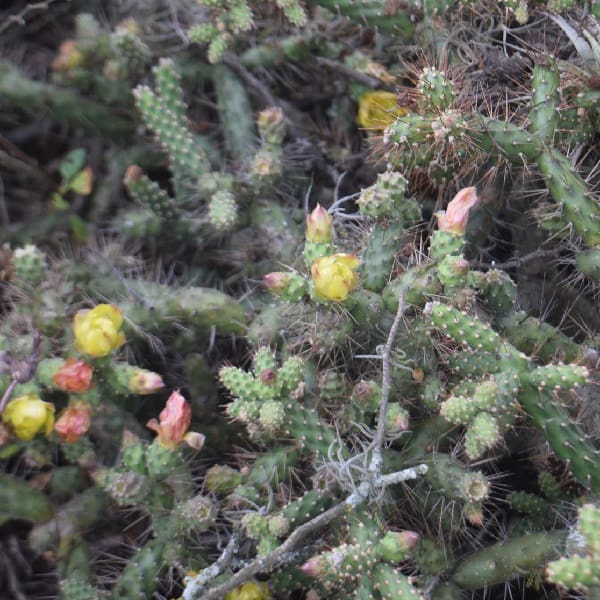
Opuntia ammophila (Florida Beach Prickly Pear)

Opuntia amyclaea

Opuntia anacantha
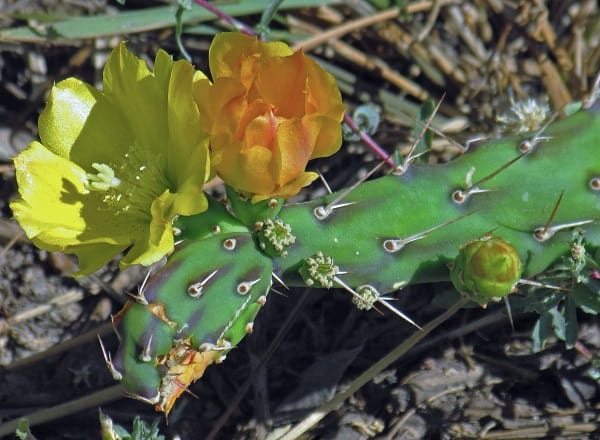
Let’s dive into the world of Opuntia anacantha, a unique shrubby cactus with fascinating features! This type of Opuntia usually grows close to the ground, with joints that root along the undersurface. Sometimes, it even climbs and reaches heights up to 2 feet, spreading out as wide as 8 feet. The joints of Opuntia anacantha can vary, some being smooth without any spines, while others might have sharp and pointy spines for protection.
What makes this cactus even more interesting is its wide range of appearances found in different places. This has led to various names being used, causing some confusion among experts. However, the friendliest variety that doesn’t have any spines seems to be the most popular choice among gardeners and cactus enthusiasts.
Opuntia anahuacensis (Beach Prickly Pear)

Opuntia arechavaletae

Opuntia arenaria (El Paso Prickly Pear)

Opuntia Argentina

Let’s talk about the Argentine Opuntia, also known as Opuntia argentina or simply the Argentia cactus. You can find these cacti in Argentina and South Africa. They have a unique appearance with large, thick, and egg-shaped “leaves” that come out from a central stem. These leaves are flat but juicy.
Opuntia arizonica (Arizona Prickly Pear)

Opuntia articulata (Paper Spine Cactus)

Opuntia atrispina (Dark-spined Prickly Pear)

Opuntia atropes

Opuntia auberi

Opuntia aurantiaca (Tiger Pear)

Opuntia aurea (Golden Prickly Pear)

Opuntia aureispina (Golden-spined Prickly Pear)

Let’s talk about Opuntia aureispina, also known as the Golden-spined Prickly Pear. This unique plant is like a tree-like shrub with many branches that grow near the ground. It reaches a height of about 3-5 feet, growing from short trunks covered in spines. As its name suggests, it stands out with long and golden spines. You’ll find that the spines are more abundant and longest on the upper part of the pads.
One of the characteristics that sets Opuntia aureispina apart from other prickly pears is its spiny fruits. These fruits start off fleshy but become dry and hard as they mature. Additionally, this cactus displays beautiful yellow flowers with reddish bases. Keep an eye out for these distinct features when observing Opuntia aureispina in all its glory!
Opuntia austrina (Florida Prickly Pear)
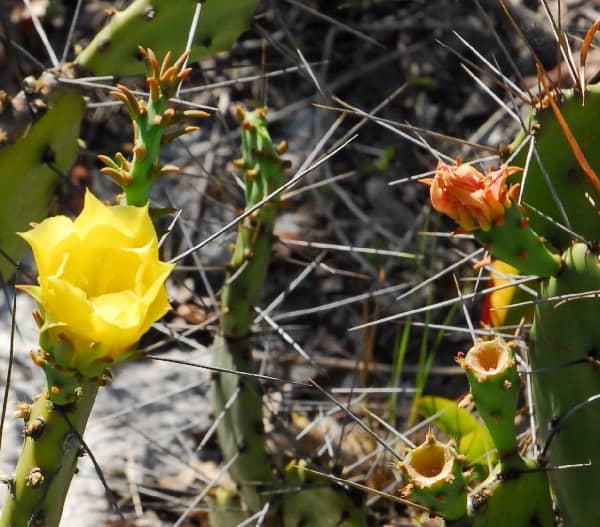
Opuntia azurea (Purple Prickly Pear)

Let’s talk about Opuntia azurea, also known as the Purple Prickly Pear. This prickly-pear cactus has long spines and a compact, upright form. It typically has a single trunk and shiny, pale blue-green arms that can reach a height of 3-6 feet. Alternatively, it may branch out from the base and spread more widely.
Opuntia azurea was initially discovered in Mexico. One of its notable features is the joints, which can vary in color depending on the season. They are typically blue-green or purple at the areoles, and during dry periods or winter, they may turn uniformly purple.
When young, the spines of Opuntia azurea are usually golden or reddish. However, as they age, they darken and take on an almost black hue. These spines primarily grow on the upper part of the cactus. The flowers of this species are truly stunning, measuring around 1.2 inches long. They have a vibrant golden-yellow color with a crimson claw. As the flowers age, they gradually transition to a pinkish-brown hue. And let’s not forget about the tasty fruits it produces. Opuntia azurea bears juicy, edible fruits that are red or purple in color.
Opuntia azurea is a visually striking cactus with its colorful joints, exquisite flowers, and delicious fruits. Keep an eye out for this remarkable species during your cactus explorations!
Opuntia basilaris (Beavertail Prickly Pear)

Let’s explore Opuntia basilaris, also known as the Beavertail Prickly Pear. This is a smaller type of prickly pear cactus that typically grows in clumps. It branches upward and can reach a height of around 12 inches (24 inches), forming clumps that can span up to 36 inches (48 inches) in diameter.
Opuntia basilaris var. brachyclada (Short-joint Beavertail Prickly Pear)

Now, let’s talk about a variation of the Beavertail Prickly Pear called Opuntia basilaris var. brachyclada, which has smaller and more compact segments. This variation is mainly found in the chaparral vegetation and the desert edges of California. Keep an eye out for this variation if you happen to be exploring those regions!
Opuntia basilaris var. heilii (Heil’s Beavertail Prickly Pear)

Opuntia basilaris var. longiareolata (Grand Canyon Beavertail Prickly Pear)

Opuntia basilaris var. longiareolata is known for its wedge-shaped and narrow stem pads. You can find this variety in the Mojave Desert, which stretches across California, Arizona, and even the Grand Canyon.
Opuntia basilaris var. treleasei (Trelease’s Beavertail Prickly Pear)

On the other hand, Opuntia basilaris var. treleasei has pads that are narrow, elliptical, or obovate in shape. Some of these pads may have a few spines. This particular variation is found in the Pacific grassland and Mojave Desert regions of California.
Opuntia bensonii

Opuntia bentonii (Beach Texas Prickly Pear)

Opuntia bergeriana (Red-flower Prickly Pear)

Let’s discover the captivating Opuntia bergeriana, also known as the Red-flower Prickly Pear. This cactus is robust and shrubby, capable of reaching heights of up to 15 feet. Its pads can grow as long as 16 inches, providing a striking appearance.
What makes Opuntia bergeriana truly mesmerizing are its vibrant red flowers. These flowers bloom abundantly, even in smaller specimens of the plant. Picture these beautiful red blooms adorning this resilient cactus, bringing a burst of color to its surroundings.
Opuntia blakeana (Unusual Arizona Prickly Pear)

Opuntia bravoana
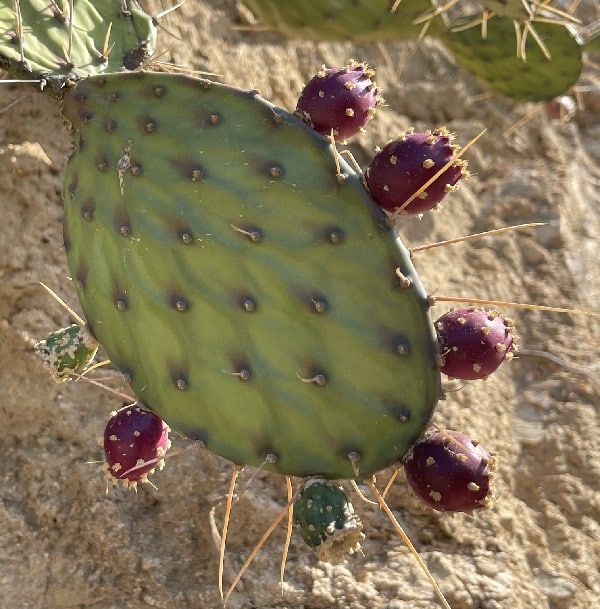
Opuntia brunnescens

Opuntia caboensis

Opuntia cacanapa (Texas Blue Prickly Pear)

Opuntia camanchica (Tulip Prickly Pear)

Opuntia caracassana

Opuntia cespitosa (Eastern Prickly Pear)

Opuntia chaffeyi

Opuntia charlestonensis (Charleston’s Prickly Pear)
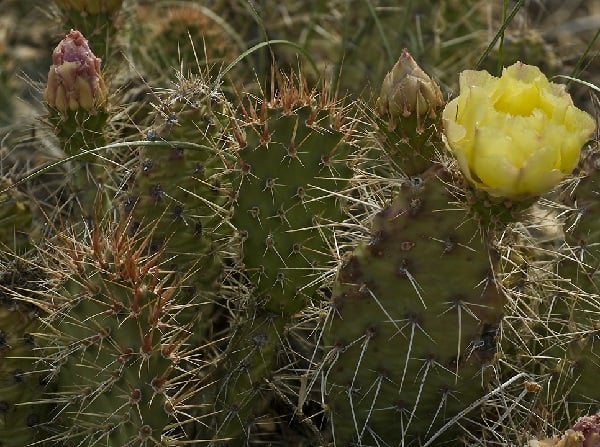
Opuntia chavena

Opuntia chiangiana

Opuntia chisosensis (Chisos Mountain Prickly Pear)

Opuntia chlorotica (Pancake Prickly Pear)

Opuntia clarkiorum

Opuntia cochenillifera (Cochineal Nopal Cactus)

Cochineal Nopal Cactus, also known as Opuntia cochenillifera, is a well-known prickly cactus that looks like a shrub or a tree. It has a few main branches starting from the base and a large, round top that can grow to be 3 to 4 meters tall or even taller. In the past, this cactus was used to produce a special insect called cochineal.
The female cochineal insects are used to make a deep red dye, which can be used to color fabric, fibers, and wool. The dye contains a substance called carminic acid, which gives off various shades of scarlet, pink, and other red colors. In Mexico, this cactus species may have been chosen for its lack of spines, similar to another cactus called Opuntia ficus-indica, to make it easier to grow.
Opuntia columbiana (Columbia Prickly Pear)

Opuntia comonduensis (Comondu Cactus)

Opuntia confusa (Widespread Western Prickly Pear)

Opuntia consoles
Opuntia cubensis (Cuban Prickly Pear)

Opuntia curassavica (Curas Cactus)

Opuntia cyclodes (Cold-hardy Western Prickly Pear)

Opuntia cymochila (Grassland Prickly Pear)

Opuntia deamii
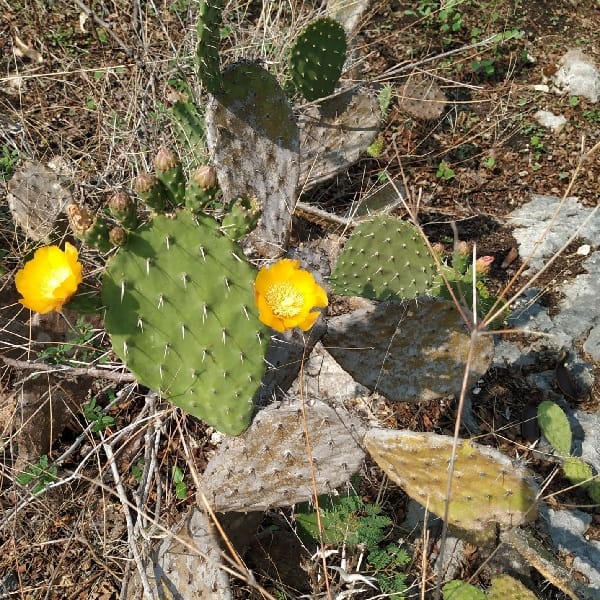
Opuntia debreczyi
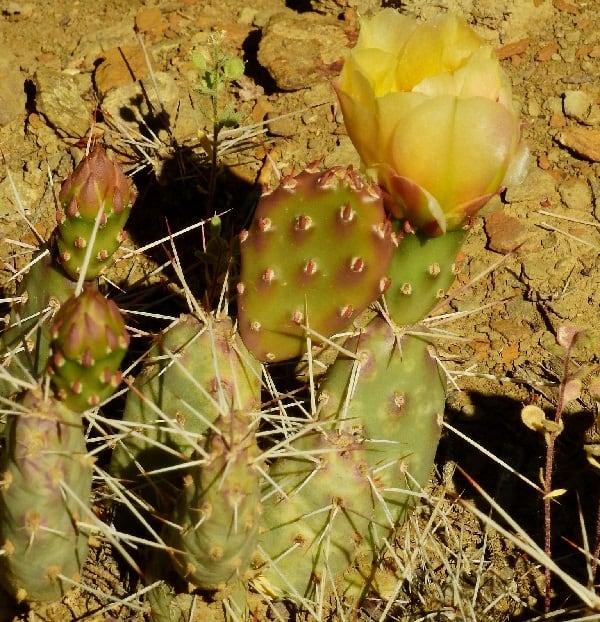
Opuntia decumbens (Decumbens Cactus)

Opuntia dejecta

Opuntia demissa

Opuntia depressa (Depressa Cactus)

Opuntia dillenii (Erect Prickly Pear)

The Erect Prickly Pear, also known as Opuntia dillenii, is a type of cactus that grows in low, spreading bushes. These bushes can form wide clumps and sometimes create dense thorny areas. Alternatively, they can grow tall, reaching heights of 6 to 10 feet. Sometimes, they have smooth, round trunks.
Opuntia diploursina (Western Prickly Pear)

Opuntia discata
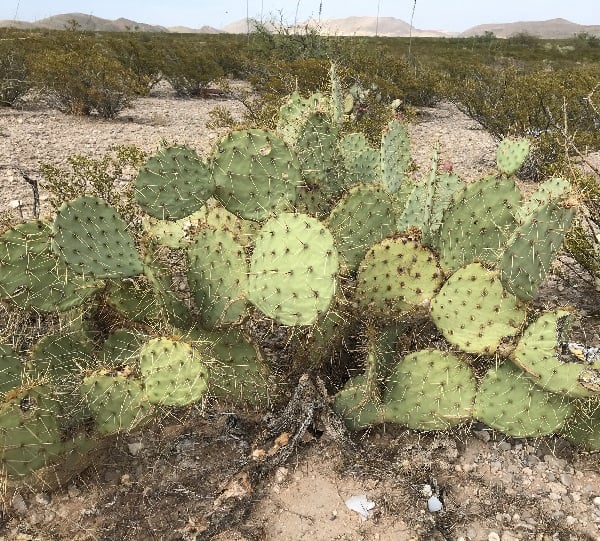
Opuntia discolor

Opuntia drummondii (Creeping Cactus)

Opuntia dulcis (Sweet Prickly Pear)

Opuntia durangensis (Durango Giant Prickly Pear)

Opuntia elata (Riverina Pear)

Opuntia elata is a rapidly growing shrub-like succulent plant. It grows upright with many branches and can eventually reach a height of 9 feet and spread out, although a more typical size is around 3-5 feet. During late spring to summer, it produces beautiful flowers in vibrant shades of deep orange to yellow. The fruit it bears is club-shaped and turns purple-red when fully ripe. Sometimes, the plant’s segments may have straight white spines that can grow up to 1.2-1.6 inches long.
Opuntia elatior (Red-flower Prickly Pear)

Opuntia elizondoana

Opuntia engelmannii (Engelmann’s Prickly Pear)

Opuntia engelmannii is a prickly pear cactus that can vary in its appearance. It usually takes the form of a dense, mound-shaped shrub, standing less than 3.3 feet tall (sometimes growing as tall as 11.5 feet, resembling a small tree). It typically does not have a noticeable trunk, although sometimes it may have a short trunk. The lower branches tend to grow along the ground, while the upper branches spread out or point upwards.
Opuntia excelsa (Lofty Prickly Pear)

Opuntia falcata
Opuntia feroacantha

Opuntia ficus-indica (Indian Fig Opuntia)
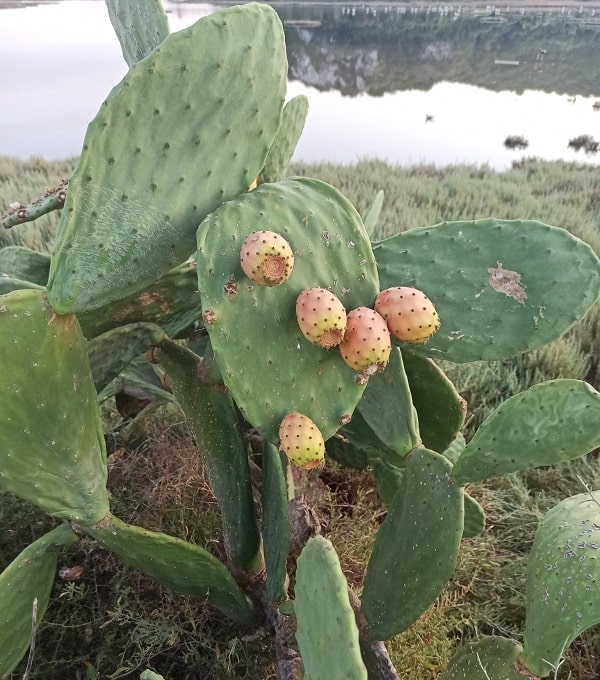
Opuntia ficus-indica is a type of prickly pear cactus that has been cultivated as a useful crop plant for a long time. It plays a significant role in agricultural economies in dry and semi-dry regions across the world.
Opuntia fragilis (Brittle Prickly Pear)

Opuntia fuliginosa

Opuntia fusco-atra

Opuntia galapageia (Galápagos Prickly Pear)

Opuntia galapageia is a type of perennial prickly pear cactus that can vary greatly in appearance. Sometimes, it grows low and spreads along the ground, while other times it becomes quite large, resembling a tree and reaching heights of 8.2-16.4 feet or even more. It has a well-developed, prominent top that can be either open or tightly rounded.
This species exhibits a wide range of variations in its overall shape, the presence of spines on the segments, and the characteristics of the spines themselves. The differences can be quite noticeable between young plants and older ones, as well as between the main trunk and the individual segments. However, these distinctions don’t hold much significance.
Opuntia gaumeri

Opuntia gilvescens

Opuntia glaucescens

Opuntia gomei
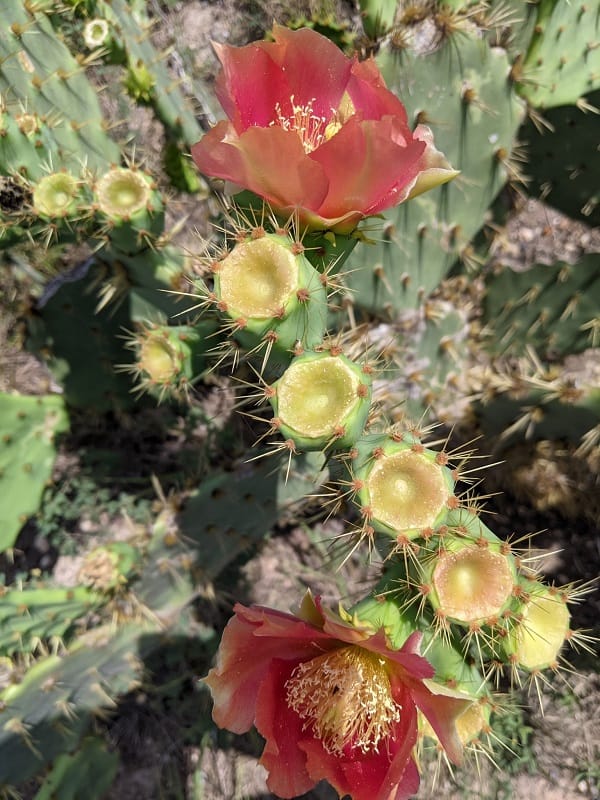
Opuntia gosseliniana (Violet Prickly Pear)

Opuntia grandis

Opuntia guatemalensis

Opuntia guilanchi

Opuntia helleri (Wolf Island Prickly Pear)

Opuntia hondurensis

Opuntia howeyi

Opuntia huajuapensis

Opuntia humifusa (Low Prickly Pear)

Opuntia humifusa is a type of plant that has segmented, flat joints. It is a perennial herbaceous plant that can form a shrub which can be prostrate (lying flat on the ground), spreading, or erect. In the wild, it often spreads to create small groups of plants, covering an area of about 3 feet across (or more, as the pads break off and take root nearby).
Opuntia hyptiacantha

Opuntia inaequilateralis

Opuntia inaperta

Opuntia insularis

Opuntia jaliscana

Opuntia jamaicensis (Jamaica Prickly Pear)
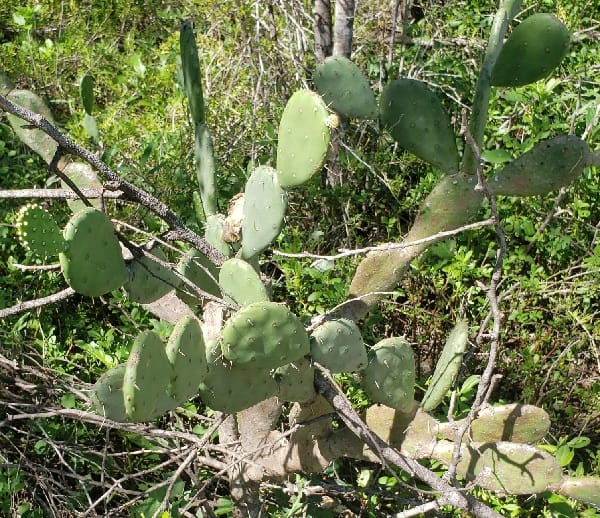
Opuntia joconostle

Opuntia karwinskiana

Opuntia keyensis
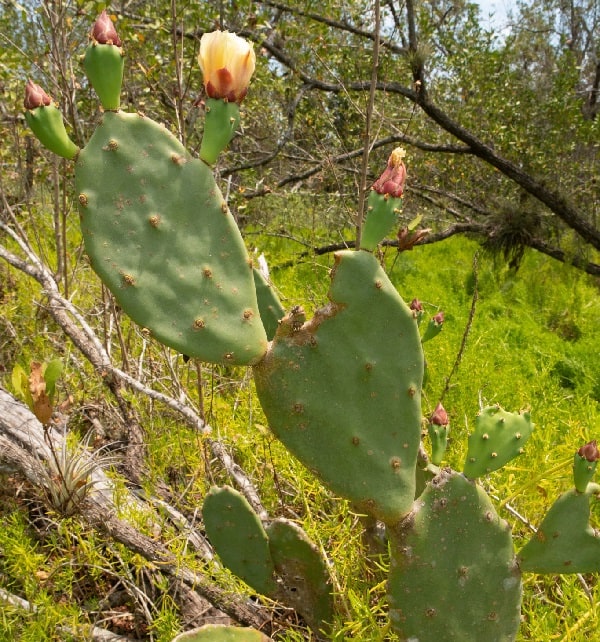
Opuntia laevis (Smooth Prickly Pear)

Opuntia lagunae

Opuntia lasiacantha

Opuntia leoglossa (Lion’s Tongue Cactus)

Opuntia leptocarpa

Opuntia leucotricha (Arborescent Prickly Pear)

Opuntia leucotricha, also known as Duraznillo, is a type of shrubby cactus that forms clumps or small trees. It has a sturdy trunk and a large top, which can grow to be 10 to 16 feet tall. The flowers of this cactus are a deep yellow color and have white stamens. The stigma, which is the female part of the flower, is deep red with green lobes. The fruit of the Duraznillo cactus is fragrant and can be either whitish-yellow (known as Duraznillo blanco) or red (known as Duraznillo colorado). The fruit has a delicious taste and can often be found in Mexican markets.
Opuntia lindheimeri (Texas Prickly Pear)
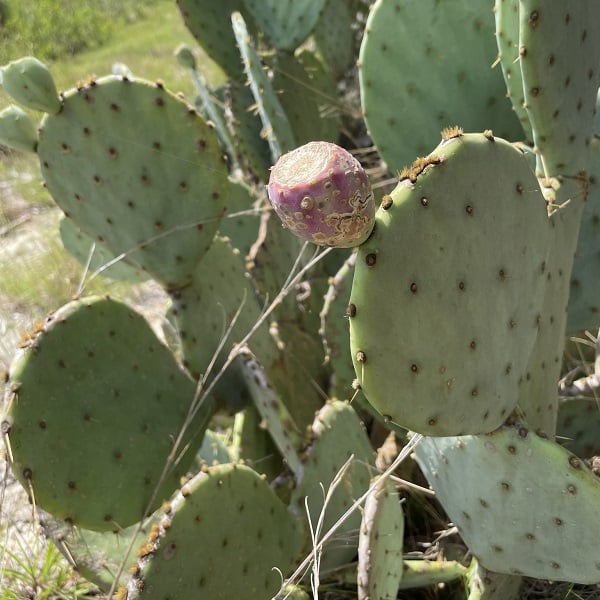
Opuntia littoralis (Coastal Prickly Pear)

Opuntia lutea

Opuntia mackensenii

Opuntia macrarthra (Eastern Beach Prickly Pear)

Opuntia macrocentra (Black-spined Prickly Pear)

Opuntia macrocentra is a type of prickly pear cactus that grows close to the ground or can be slightly upright. These cacti are typically branched shrubs that stand between 24-47 inches tall and can spread out up to 10 feet wide. They usually have 4-10 segments stacked on top of each other, and sometimes, they may have noticeable trunks, although this is uncommon.
What sets Opuntia macrocentra apart from other prickly pear species are its succulent pads that have a reddish tint and very long spines. In fact, the name macrocentra means “long spine.” This cactus often has a purple hue most concentrated around the areoles (the spots from which spines grow) and along the edges. During winter, the entire plant may turn purple.
Opuntia macrorhiza (Prairie Prickly Pear)

Opuntia macrorhiza plants grow in mats, spreading out with chains of joints that root themselves when they touch the soil. These plants do not have a central taproot with tuber-like growth.
Opuntia maxima
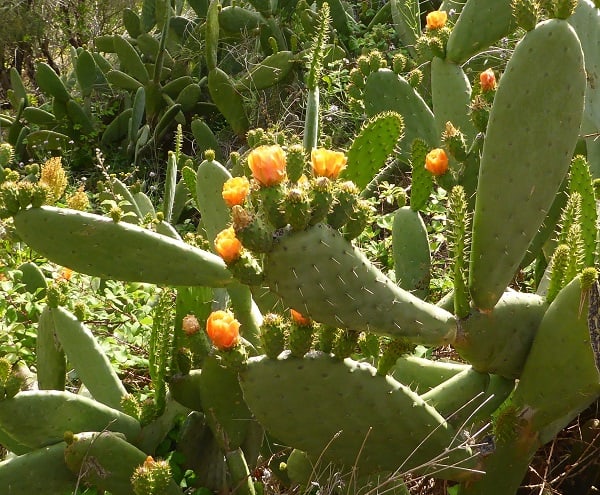
Opuntia megapotamica

Opuntia megarrhiza

Opuntia megasperma

Opuntia mesacantha (Southeastern Prickly Pear)

Opuntia mesacantha subs. lata

Opuntia microdasys (Bunny Ears Cactus)

Opuntia microdasys is a cactus that generally grows close to the ground, with a low and spreading form. Sometimes, though, it can grow upright and reach up to 3 feet tall, forming small clumps. The stems of this cactus look like small pads and don’t have spines. Instead, they have densely packed golden-yellow glochids, which are hair-like prickles. While it can produce yellow flowers, they rarely bloom when cultivated.
There are various types of Opuntia microdasys, and they can be distinguished by the shape, size, and color of their joints and glochids. This cactus is highly popular among collectors of all kinds, as it is easy to grow and undoubtedly a very attractive plant.
Opuntia mojavensis

Opuntia monacantha (Drooping Prickly Pear)
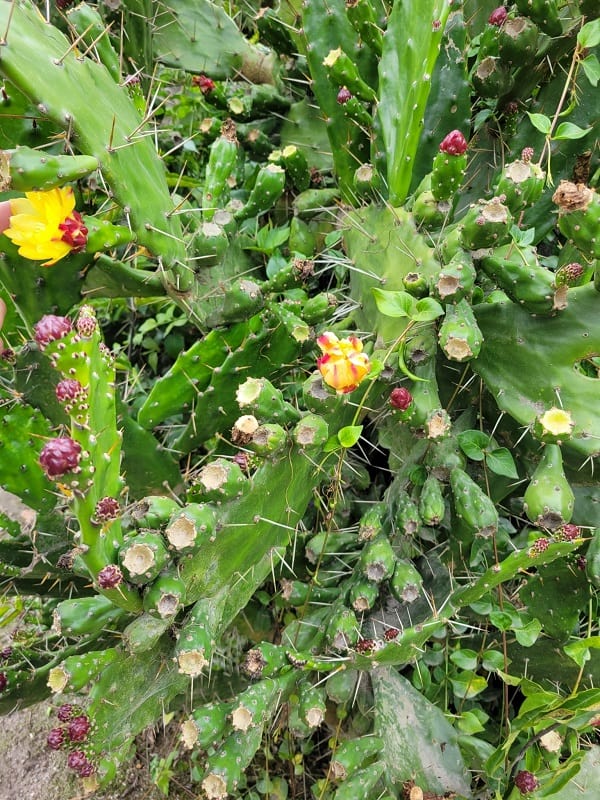
Opuntia monacantha is a succulent plant that grows quickly and has a shrubby or tree-like form. It can reach heights of 7-13 feet (up to 20 feet in some cases) and has a short trunk that can be around 6.5 feet in diameter.
Opuntia nejapensis
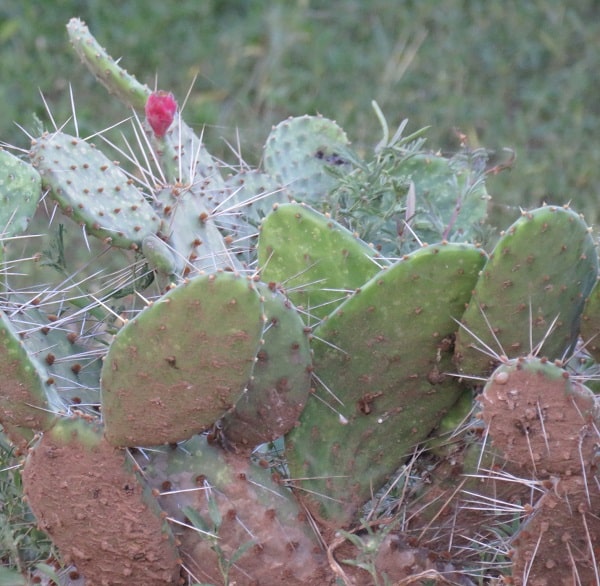
Opuntia nemoralis

Opuntia neochrysacantha

Opuntia ochrocentra

Opuntia oligacantha

Opuntia olmeca

Opuntia orbiculata (Western Prickly Pear)

Opuntia oricola (Chaparral Prickly Pear)

Opuntia pachyrrhiza

Opuntia parviclada

Opuntia perotensis

Opuntia phaeacantha (Brown-spined Prickly Pear)

Opuntia phaeacantha is a group of medium-sized prickly pear cacti, known for their brown spines. These plants can grow erect or spread out on the ground, reaching heights of 24-35 inches (and sometimes even taller). They don’t have a trunk and can form dense thickets, covering an area of up to 8 feet across. On the other hand, some plants remain low and prostrate, with their stem segments (pads) resting flat on the ground, never growing taller than 16 inches.
These cacti are characterized by their weak stems and pads that tend to sag or lie on the ground, particularly during the winter months. The flowers are golden yellow with a yellow to reddish center. Opuntia phaeacantha is one of the most common cacti in North America, representing the typical image people have of a prickly pear cactus. Many varieties of this cactus have only a few spines.
Opuntia pilifera

Opuntia pinkavae (Pinkava’s Prickly Pear)
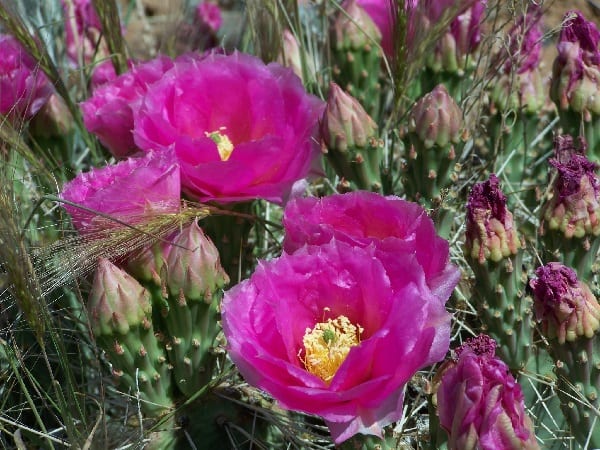
Opuntia polyacantha
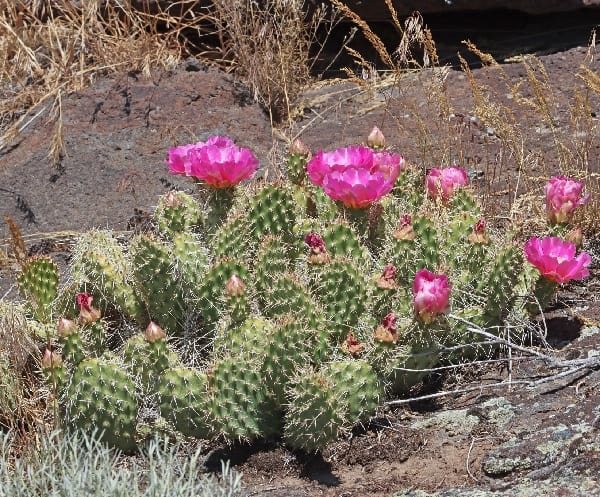
Opuntia polyacantha is a low, spreading shrubby plant that grows as a perennial. It has many branches and can reach heights of 4-8 inches tall (up to 16 inches in some cases). Typically, it forms small clusters or mats of pads that can be around 6.5-10 feet wide. In the Great Plains, mats as wide as 12 feet and as long as 30 feet have been observed.
The lifespan of Opuntia polyacantha plants is usually less than 20 years. However, through vegetative propagation, where new plants are produced from existing ones, the clonal colony can have a much longer lifespan.
Opuntia polyacantha var. erinacea (Mojave Prickly Pear)

Opuntia polyacantha var. erinacea is a variety of the prickly pear cactus known for its long spines that can reach up to 4 inches in length. Its fruits are also covered in many spines. This variety is commonly found in the western United States.
Opuntia polyacantha var. hystricina (Porcupine Prickly Pear)
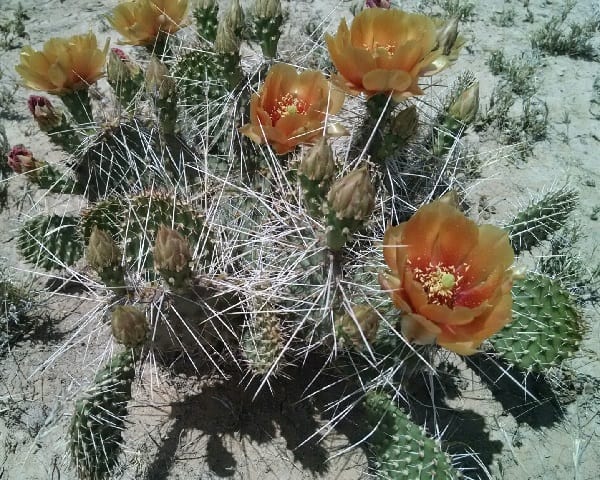
Opuntia polyacantha var. hystricina is another variety of the prickly pear cactus. It also has spines that can grow up to 4 inches long, but its fruits only have spines on the upper part. This variety is found in northern Arizona to Colorado.
Opuntia polyacantha var. juniperina (Panhandle Prickly Pear)

Opuntia polyacantha var. nicholii (Navajo Bridge Prickly Pear)

Opuntia polyacantha var. nicholii has spines up to 5 inches long, and some spines on the fruits. It is found in Navajoan.
Opuntia polyacantha var. schweriniana (Dwarf Cactus)

Opuntia pottsii

Opuntia pottsii is a small shrubby plant that can reach up to 5-12 inches tall, and it forms wide spreading clumps up to 6 feet in diameter. This plant is not easily noticeable, as it blends in with its surroundings. It grows from a type of root called a tuber. The pads of the plant appear bluish-green and have a waxy coating, giving them a glaucous appearance. On the upper part of the pads, you’ll usually find 1 to 3 gray-white spines per area.
In the areas where Opuntia pottsii is found, the flowers can be red, magenta, pink, orange, yellow, or white. Sometimes, you may even find a combination of these colors within the same group of plants. When the flowers are yellow, they often have red centers.
Opuntia pottsii var. montana
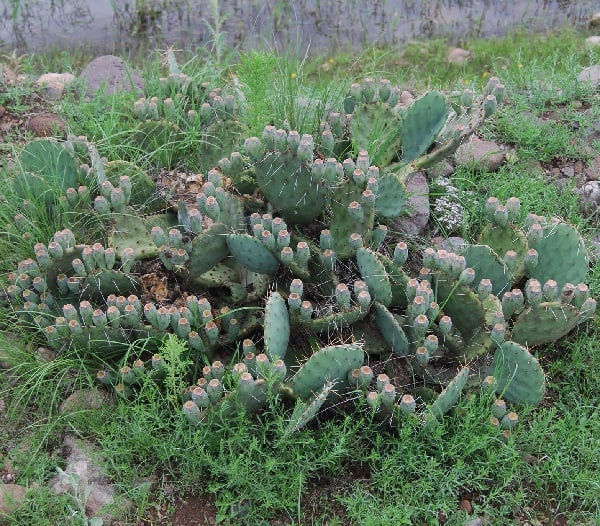
Opuntia pottsii var. montana has joints that are generally wider than they are long. The spines on this plant are typically white in color. The fruit of this plant is mostly short and chunky, usually appearing pinkish. You can find this plant in areas with conifer or oak trees, specifically in woodlands that are located above 1,800 meters in elevation. Sometimes, you may also come across it in grasslands at lower elevations.
Opuntia puberula
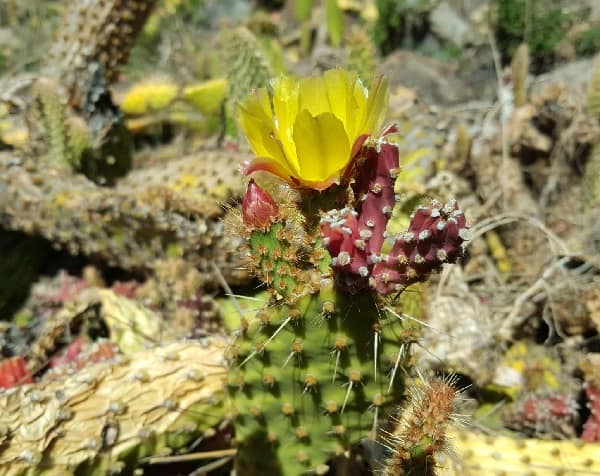
Opuntia pubescens (Velvet Bur Cactus)
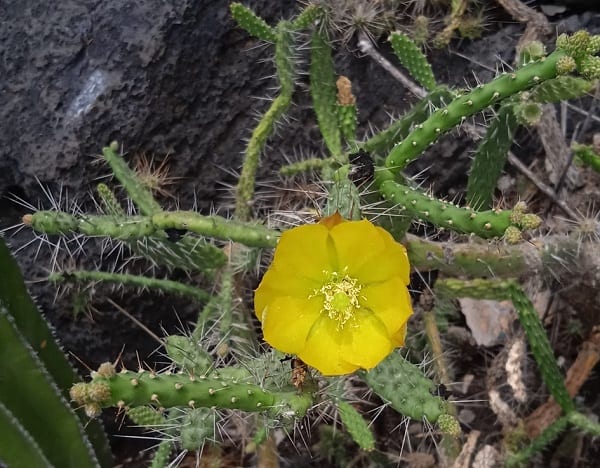
Opuntia pumila

Opuntia pycnantha
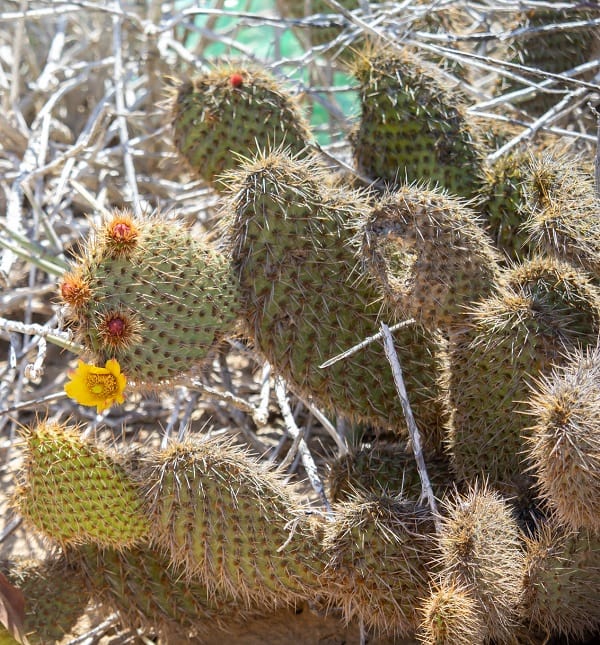
Opuntia pyrocarpa

Opuntia quimilo

Opuntia quimilo is a heavily branched shrub or cactus that can grow like a tree. It has distinct trunks that can reach up to 12 inches in diameter, while its height and diameter can extend up to 13 feet. Some people mistakenly think that the large, flat pads of prickly pears, like Opuntia quimilo, are leaves. In reality, these pads are called cladodes or stem segments that carry temporary green leaves and spines.
Opuntia quimilo is one of three known cacti that exhibit a reproductive system called gynodioecy. This means that some plants have female flowers, while others have flowers that contain both male and female reproductive parts.
Opuntia quitensis

Opuntia quitensis is a succulent bush that sprawls or grows somewhat upright. It typically has single stems but can form large thickets that are usually around 1-7 feet tall. However, in dense vegetation, it can grow even taller, reaching up to 10 feet.
The appearance of this species can vary widely. When it grows in open areas, it tends to have a low and bushy form with relatively small joints (or pads). On the other hand, when it grows in thickets, it becomes tall and has larger joints.
Most of the time, Opuntia quitensis doesn’t have any spines. But if spines are present, they are usually few in number and not very strong. However, there are occasions when the joints may have sturdy, needle-like spines.
Opuntia rastrera

Opuntia repens (Roving Prickly Pear)
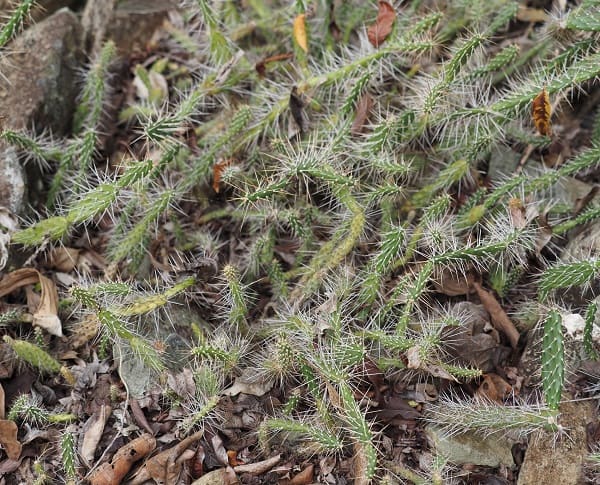
Opuntia retrorsa

Opuntia rileyi
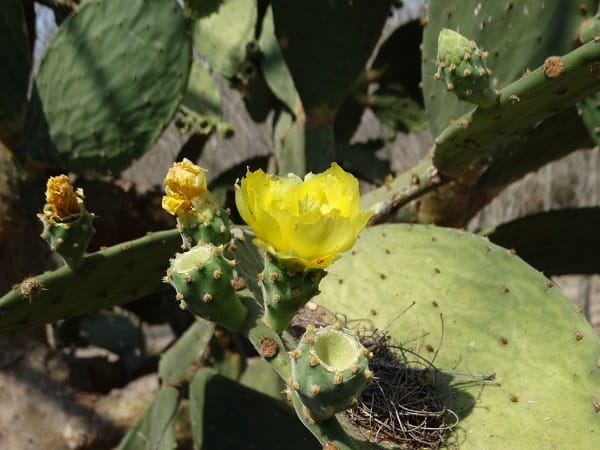
Opuntia rioplatense

Opuntia robusta (Nopal Tapón)

Opuntia robusta, also known as the ‘wheel cactus’ due to its circular segments, is a succulent shrub or small tree with many branches. It can grow upright and reach heights of around 13-20 feet, but it is usually 3 to 7 feet tall, with clear trunks.
The segments of the branches are often mistaken for leaves but they are actually flattened stems. They have many barbed bristles called glochids, and they usually don’t have any spines. However, sometimes there can be 1 to 5 sharp spines up to 2 inches long growing from each area on the segments.
In Opuntia robusta, you can find plants with male flowers, plants with female flowers, and plants with flowers that contain both male and female parts. The fruits produced by this cactus can be red, orange, yellow, or green. They have a thick peel with sharp glochids and juicy pulp that contains numerous seeds. While they are edible, they are best suited for feeding animals.
Opuntia rufida (Blind Prickly Pear)

Opuntia rufida is a large shrubby or tree-like prickly pear cactus that has a bluish-green color. It has multiple branches and occasionally a somewhat defined trunk, which can grow up to 5 feet tall and 8 feet wide. This cactus doesn’t have any spines, but its joints have many evenly spaced areas called areoles. These areoles contain numerous reddish glochids.
The names “blind prickly pear” in English and “nopal cegador” in Spanish come from the belief that the glochids can be easily dislodged and may float into the air when the plants are shaken. This can be quite troublesome because if these glochids get into the eyes of animals, they can cause severe problems.
Opuntia rugosa

Opuntia rzedowskii

Opuntia salmiana

Opuntia salmiana is a bushy type of Opuntia cactus that can grow up to 6 feet tall. It has many branches near its base. The plant produces lovely large yellow flowers that create a beautiful contrast with the red-purple color of the young stems. It can even flower well when grown indoors.
Interestingly, the fruits of this plant are quite unique. They have a high tendency to multiply rapidly. Each side fruit has the ability to break away from the main part and grow into a new plant. Surprisingly, the fruits of this species do not contain any seeds, and new plants are formed solely through vegetative reproduction.
Opuntia sanguinocula

Opuntia santa-rita (Santa Rita Prickly Pear)

Opuntia santa-rita is a tall and wide succulent shrub that stands at about 6 feet in height and 10 feet in width. It has a noticeable but short trunk. This species is quite captivating, displaying reddish or violet-purple pads. Interestingly, smaller plants tend to showcase the most vibrant colors. During spring, the bright yellow flowers on the purple pads create a stunning sight, surely capturing everyone’s attention.
Opuntia scheeri

Opuntia schickendantzii

Opuntia semispinosa

Opuntia senilis

Opuntia sierralagunensis

Opuntia soederstromiana

Opuntia sphaerica

Opuntia sphaerica is a resilient plant that can survive and adapt to various weather, terrain, and climate conditions. It thrives in different environments. You can find them in areas with high drought, near the seaside, at elevations ranging from 115-11,500 feet, on slopes, and on flat terrain.
Opuntia sphaerica is known by several scientific names, including Cumulopuntia sphaerica, Sphaeropuntia sphaerica, and Tephrocactus sphaericus. It also has colloquial names like ‘corotilla’, ‘gatito’, ‘perrito’, and ‘puskaye’.
Opuntia spinosibacca

Opuntia spinosissima (Jamaican Semaphore Cactus)

Opuntia spinulifera (Large Round-leaved Prickly Pear)

Opuntia stenopetala (Tuna Colorada)

Opuntia stenopetala is a small and bushy plant that often grows in dense groups or spreads out like mats. Its main branches crawl and rest on the edges of the joints. While its overall appearance is similar to other Opuntia species, its flowers are quite distinctive. The petals are very narrow and stand upright, giving the plant a unique and beautiful look. When it blooms, it becomes adorned with numerous small and lovely flowers.
Opuntia streptacantha

Opuntia stricta (Shell Mound Pricklypear)

Opuntia stricta subs. esparzae

Opuntia strigil (Marble-fruit Prickly Pear)

Opuntia sulphurea

Opuntia sulphurea is a short and spreading or upright shrub that creates wide clusters, about 3 to 7 feet in diameter and 12-16 inches high. The segments have noticeable bumps called tubercles. The spines on this plant are tightly packed and rigid. They start off white but gradually turn yellowish or brownish-red as they age.
Opuntia tapona
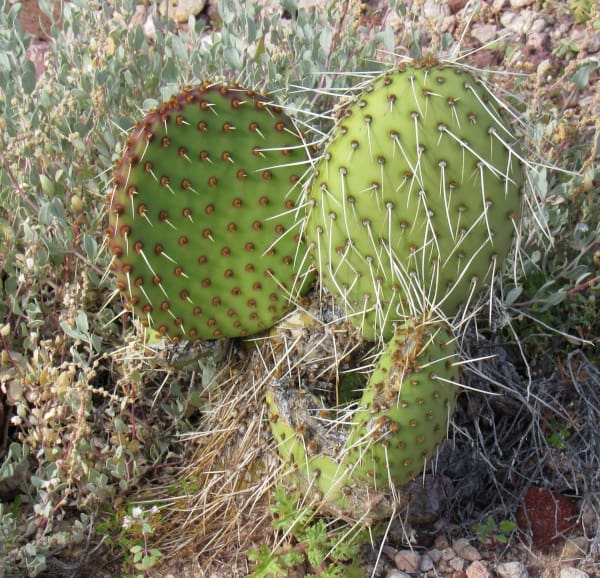
Opuntia taylorii

Opuntia tehuacana

Opuntia tomentosa (Woollyjoint Prickly Pear)
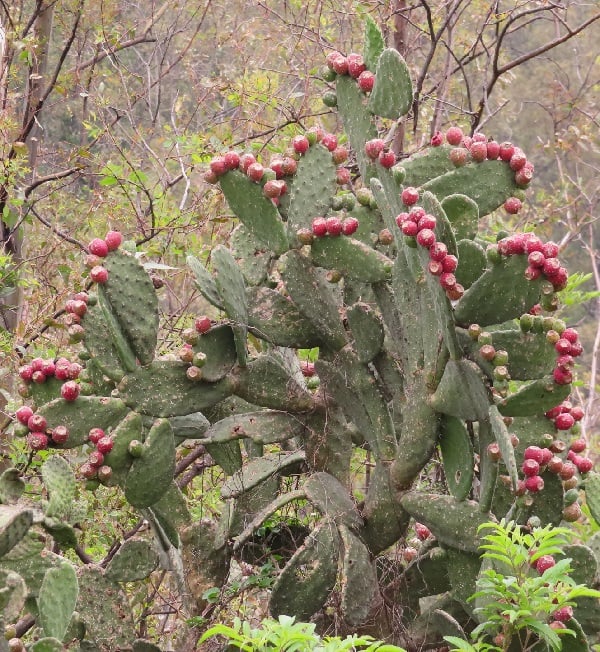
Opuntia tomentosa is a shrub-like or tree-like plant that can reach a height of 10 to 20 feet, sometimes even up to 26 feet. It has a wide, smooth trunk and its segments, often mistaken for leaves, have a dull green color and a velvety texture due to a dense covering of short, fine hairs. The flowers of this plant are deep orange in color.
This species was initially described from cultivated plants and has been a popular choice for a long time. When grown outdoors, it becomes a large and noticeable plant. It typically does not have many or any spines, but plants from the Valley of Mexico may have spines.
Opuntia tortispina (Twist-spined Prickly Pear)

Opuntia toumeyi

Opuntia triacanthos

Opuntia trichophora

Opuntia tuna

Opuntia tunoidea (Carolina Prickly-pear Cactus)

Opuntia turpinii
Opuntia undulata

Opuntia valida

Opuntia velutina

Opuntia violacea

Opuntia whipplei

Whipple cholla, also known as Opuntia whipplei, is a compact succulent shrub that is shorter and more tightly packed compared to other chollas. It can grow low and spread out like a mat or stand upright without a well-defined trunk. The appearance of this plant can vary quite a bit.
The height and width of Opuntia whipplei differ depending on the growing conditions. In certain areas, it can grow up to 4 feet tall in thick clusters. In other locations, it reaches a height of about 12-20 inches and spreads several feet wide, resembling an open shrub. In some places, it forms a dense, low mat.
Many of the cultivated varieties chosen for gardens have a dense covering of sharp, glass-white spines that shine when light passes through them. The flowers of Opuntia whipplei are large and have a yellow-green color.
Opuntia wilcoxii

Opuntia woodsii

Opuntia wootonii (Wooton Prickly Pear)

Opuntia xanthoglochia

Opuntia zuniensis (Zuni Prickly Pear)

How to Care for Opuntia Cacti
If you want to grow Opuntia cacti in your garden, here’s what you need to know to keep them healthy.
Light
Opuntia cacti need lots of direct sunlight to grow and bloom. It’s best to place them in open spaces like gardens or balconies where they can soak up the sun all day. During the hot summer months, give them some shade to protect them from extreme heat.
Watering
Opuntia cacti are used to dry conditions and don’t need a lot of water. Overwatering can harm them, so water slowly and wait to see if the water flows out of the bottom of the pot. Empty any water that collects in the tray underneath to prevent water buildup.
During the spring, summer, and fall, water them once or twice a week to keep the soil slightly wet. In the winter, water them just enough to prevent the soil from drying out too much. It’s best to use distilled water or rainwater instead of tap water, which can have minerals and chemicals that could harm the soil. Avoid splashing water on the stem to avoid rotting.
Soil
Opuntia cacti thrive in soil that has gravel, allows water to pass through, and is fertile. The ideal soil mixture for home gardening is 20% coco coir/peat moss, 60% vermiculite, 20% sandy soil, and a small amount of organic potting soil. Vermiculite allows air to reach the roots, which is crucial to prevent root rot.
The soil should also drain well, so water doesn’t pool at the surface. Repotting and loosening the soil annually help maintain good airflow. Adding vermicompost and eggshell powder can improve soil fertility.
Fertilizing
During the growing seasons (spring, summer, and fall), fertilize your Opuntia cacti with liquid fertilizer once a month. Avoid fertilizing in winter, but if you’re repotting, you can add a small amount of slow-release fertilizer to sustain them. Use phosphate-potassium fertilizers before and after the cactus blooms, and nitrogen fertilizer during the seedling phase. Remember to use low-concentration fertilizers and fertilize multiple times to avoid over-fertilizing.
Climate
Opuntia cacti thrive in hot and dry conditions, similar to deserts. They also do well in subtropical and tropical regions. The ideal temperature range for Opuntia cacti is between 68 and 95°F. If the temperatures drop below 50 or go above 95, the plant’s growth slows down. Make sure the plant is in a well-ventilated area with low humidity to avoid water accumulation.
Pests and Diseases
Opuntia cacti can be affected by various pests and diseases, including anthracnose (black dots caused by humidity and temperature), stem rot (caused by insects, cold wounds, or infected soil), root-knot nematode (insects that darken the stem and leaf surfaces), spider mites (tiny insects that cause reddening and yellowing of leaves), aphids (pests that cause stunted growth and yellowing), and other problems like mealybugs, soft rot, viruses, rodents, and dry rot.
Pruning
Opuntia cacti require minimal pruning. Simply remove any dead or withered branches and flowers to prevent spread of disease.
Potting and Repotting
Pot Opuntia cacti when the temperatures are between 59 and 68°F, usually in fall or spring. Use clay pots that allow water to pass through, and ensure they’re not too small or too large. Repotting once a year is only needed for potted plants. Lift the whole plant, remove old soil, place it in a new container, and fill it with potting soil.
How to Propagate Opuntia Cacti
You can propagate Opuntia cacti through division or grafting. To divide, cut off lateral branches or the plant’s tip and plant them in soil. Small shoots will start growing in a few months. For grafting, use a suitable rootstock. Cut off its tip and place the Opuntia cactus without roots in the center, securing them with rope. After a couple of weeks, the parts will grow together, and you can remove the rope. You can also try growing Opuntia cacti from seeds.




